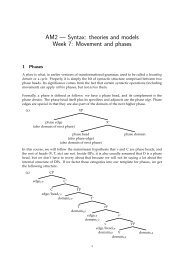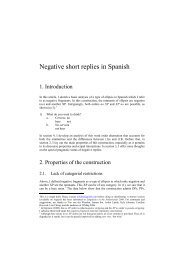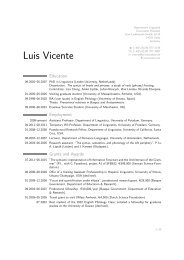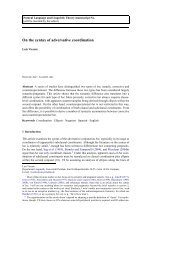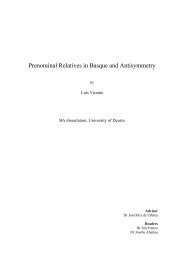Verb fronting in Mandarin Chinese - Luis Vicente
Verb fronting in Mandarin Chinese - Luis Vicente
Verb fronting in Mandarin Chinese - Luis Vicente
Create successful ePaper yourself
Turn your PDF publications into a flip-book with our unique Google optimized e-Paper software.
<strong>Verb</strong> <strong>front<strong>in</strong>g</strong> <strong>in</strong> Mandar<strong>in</strong> Ch<strong>in</strong>ese<br />
<strong>Luis</strong> <strong>Vicente</strong><br />
UC Santa Cruz<br />
koldito@gmail.com<br />
Lisa Cheng<br />
Leiden University<br />
l.l.cheng@let.leidenuniv.nl<br />
October 31, 2008<br />
1 Introduction<br />
Mandar<strong>in</strong> Ch<strong>in</strong>ese has a VP topicalization construction (Huang 1988).<br />
(1) [ V P pip<strong>in</strong>g ziji i de pengyou], Zhangsan zhidao Lisi i juedui bu hui<br />
criticize self’s friend Zhangsan knows Lisi def<strong>in</strong>itely not will<br />
“Criticize his i own friends, Zhangsan knows that Lisi i will def<strong>in</strong>itely not do so.”<br />
It also has a verb doubl<strong>in</strong>g process with resultatives (Cheng 2007 and references).<br />
(2) ta qi nei pi ma qi de hen lei<br />
he ride that cl horse ride res very tired<br />
“He rode the horse, and the horse got tired”<br />
Someth<strong>in</strong>g almost undescribed so far (Liu 2004; Constant and Gu 2008): two processes that<br />
comb<strong>in</strong>e verb topicalization with verb doubl<strong>in</strong>g.<br />
• First construction: verbal clefts.<br />
(3) Q: ni chi-guo fan meiyou?<br />
you eat.asp rice not.have<br />
“Have you already eaten?”<br />
A: chi,<br />
eat<br />
wo<br />
I<br />
shi chi-guo le, bu guo...<br />
cop eat.asp sfp but<br />
“As for eat<strong>in</strong>g, I have (<strong>in</strong>deed) eaten, but (I still feel hungry)”<br />
• Second construction: verbal lian...dou<br />
(4) ta lian kan dou mei kan<br />
he lian look dou not.have look<br />
“He didn’t even look”<br />
We call both constructions verbal because they are subcases of the more general cleft and lian...dou<br />
constructions, respectively. Note that only the verbal versions feature double pronunciation.<br />
(5) a. Zhangsan shi zuotian kandao (*zuotian) Wang xiaojie<br />
Zhangsan cop yesterday see yesterday Wang ms<br />
“It is yesterday that Zhangsan saw Ms. Wang”<br />
1
Cheng & <strong>Vicente</strong><br />
<strong>Verb</strong> <strong>front<strong>in</strong>g</strong> <strong>in</strong> Mandar<strong>in</strong><br />
UCSC L<strong>in</strong>guistics Colloquium<br />
October 31, 2008<br />
b. ta lian zhe-be shu dou kan-le (*zhe-be shu)<br />
he lian this.cl book dou read.asp this.cl book<br />
“He read even this book”<br />
Although verb-<strong>front<strong>in</strong>g</strong>-plus-doubl<strong>in</strong>g constructions do not exist <strong>in</strong> (Standard) English, they are extremely<br />
common crossl<strong>in</strong>guistically, and they are usually referred to as predicate clefts.<br />
(6) Some languages with predicate clefts (mostly from Kandybowicz 2006)<br />
Akan, Basque, Brazilian Portuguese, Brazilian Sign Language, Bulì, Capeverdean, Caribbean<br />
English Creole, Ch<strong>in</strong>ese, Edo, Eŵe, Fongbe, French, Guadeloupe, Gullah, Gungbe, Haitian<br />
Creole, Hausa, Hebrew, Hungarian, Igbo, Île de France Creole, Jamaican, Japanese, Korean,<br />
Krio, Mauritian Creole, Negerhollands, Nupe, Nweh, Papiamentu, Rodrigues Island Creole,<br />
Russian, Saramacan, Seselwa, Spanish, Sranan, Tr<strong>in</strong>idad Dialect English, Turkish, Twi, Vata,<br />
Yiddish, Yoruba.<br />
(7) Comer, pro he comido<br />
eat.<strong>in</strong>f I have eaten<br />
“As for eat<strong>in</strong>g, I have <strong>in</strong>deed eaten” [Spanish, <strong>Vicente</strong> 2007]<br />
(8) Olvasni, olvasta János egy könyvet<br />
read.<strong>in</strong>f, read.pst.3sg János a book.acc<br />
“As for read<strong>in</strong>g, János has <strong>in</strong>deed read a book” [Hungarian, <strong>Vicente</strong> 2007]<br />
Normally, predicate clefts give rise to a verum focus read<strong>in</strong>g (focus on the truth of the proposition),<br />
though this is not always the case –e.g., <strong>in</strong> French, they create a high degree/surprise read<strong>in</strong>g.<br />
(9) Pour manger des pommes, Laurent a mangé des pommes<br />
for eat.<strong>in</strong>f of.the apples Laurent has eaten of.the apples<br />
“As for eat<strong>in</strong>g apples, look at how many Laurent has eaten!”<br />
[French, J. Rooryck p.c.]<br />
In all languages, the lower <strong>in</strong>stance of the verb appears <strong>in</strong>flected as appropriate. As for the upper copy,<br />
it tends to be realized as an <strong>in</strong>f<strong>in</strong>itive/bare verb form <strong>in</strong> European and Asian languages (<strong>in</strong>clud<strong>in</strong>g<br />
Ch<strong>in</strong>ese). On the other hand, African and Creole languages tend to realize it as a nom<strong>in</strong>alized verb.<br />
(10) a. (ká) dĒ-kā àlī Àtìm dĒ mángò-kǔ dīem<br />
foc eat.nomlzr comp Atìm eat mango.det yesterday<br />
“It is eat<strong>in</strong>g that Àtìm did with the mango yesterday” [Bulì, Hiraiwa 2005]<br />
b. Bi-ba Musa à ba nakàn o<br />
redup-cut Musa fut cut meat foc<br />
“It is cutt<strong>in</strong>g that Musa will do to the meat” [Nupe, Kandybowicz 2006]<br />
The syntactic properties of predicate clefts are also very well-def<strong>in</strong>ed:<br />
• In many languages, the relation between the two verbs is one of movement (exceptions: Yiddish,<br />
various idiolects of Spanish and Brazilian Portuguese).<br />
• Movement targets a constituent <strong>in</strong> the extended VP area, though the exact projection may vary<br />
among languages.<br />
• Double pronunciation is a last-resort strategy to salvage an otherwise deviant structure.<br />
2 of 13
Cheng & <strong>Vicente</strong><br />
<strong>Verb</strong> <strong>front<strong>in</strong>g</strong> <strong>in</strong> Mandar<strong>in</strong><br />
UCSC L<strong>in</strong>guistics Colloquium<br />
October 31, 2008<br />
In this talk. ..<br />
• If we obviate double pronunciation, verbal clefts and verbal lian...dou have the exact same<br />
syntax as regular clefts and verbal lian...dou.<br />
• Several tests show that the two verbs are l<strong>in</strong>ks of one and the same movement cha<strong>in</strong>, as <strong>in</strong><br />
several other languages where comparable constructions exist.<br />
• Despite these similarities, verbal clefts and verbal lian...dou sentences differ on the trigger of<br />
double pronunciation.<br />
2 <strong>Verb</strong>al clefts<br />
2.1 Brief survey of Mandar<strong>in</strong> clefts<br />
Mandar<strong>in</strong> clefts are focus constructions built around the copular verb shi. Focus falls on the constituent<br />
immediately follow<strong>in</strong>g shi.<br />
(11) a. zhei ben shu shi [ FOC ta] kan-le, keshi...<br />
this cl book cop he read.asp but<br />
“This book, it is he who read it, but...”<br />
b. shi [ FOC Zhangsan] zuotian kandao Wang xiaojie, bu shi<br />
cop Zhangsan yesterday see Wang ms not cop<br />
“It is Zhangsan who saw Ms. Wang yesterday, not Lisi”<br />
[ FOC Lisi]<br />
Lisi<br />
Cheng (to app.a) proposes that clefts are <strong>in</strong>verse predication structures: shi takes a small clause<br />
complement, whose pro predicate raises to the left of shi.<br />
(12) Structure of shi sentences<br />
a. shi [[subject] [pro]]<br />
b. [pro] shi [[subject] [ t ]]<br />
(13) a. Shi wo<br />
cop I<br />
“It is me”<br />
b. [pro] [shi [ SC wo t]]<br />
Constituents belong<strong>in</strong>g to the small clause subject can also appear to the left of shi (float<strong>in</strong>g shi)<br />
These constituents are <strong>in</strong>terpreted as topicalized.<br />
(14) a. Zhangsan [shi [ FOC zuotian ] kandao Wang xiaojie]<br />
Zhangsan cop yesterday see Wang ms<br />
“It is yesterday that Zhangsan saw Ms Wang.”<br />
b. Zhangsan zuotian [shi [ FOC kandao] Wang xiaojie]<br />
Zhangsan yesterday cop see Wang ms<br />
“It is see<strong>in</strong>g that Zhangsan did to Ms Wang yesterday”<br />
3 of 13
Cheng & <strong>Vicente</strong><br />
<strong>Verb</strong> <strong>front<strong>in</strong>g</strong> <strong>in</strong> Mandar<strong>in</strong><br />
UCSC L<strong>in</strong>guistics Colloquium<br />
October 31, 2008<br />
Focus falls on the constituent immediately follow<strong>in</strong>g shi. S<strong>in</strong>ce focalized constituents are clearly displaced<br />
with<strong>in</strong> the small clause subject, we may assume a specialized focus projection.<br />
(15) shi [ SC Taibei ta qu-guo t ] (bu shi Taizhong)<br />
cop Taipei he go.asp not cop Taizhong<br />
“It is Taipei that he went to, and not Taizhong”<br />
Non-verbal clefts have a contrastive focus read<strong>in</strong>g –i.e., the denotation of the focused constituent is<br />
contrasted aga<strong>in</strong>st a set of Roothian alternatives. On the other hand, verbal clefts have a verum focus<br />
read<strong>in</strong>g, where it is the truth value of the proposition that is contrasted aga<strong>in</strong>st the opposite truth<br />
value. <strong>Verb</strong>al clefts also give rise to an adversative implicature (a but effect), which may be only<br />
implicit.<br />
(16) chi,<br />
eat<br />
wo<br />
I<br />
shi chi-guo le, bu guo. . .<br />
cop eat.asp sfp but<br />
“As for eat<strong>in</strong>g, it is true that I have eaten, but (I still feel hungry)”<br />
Note also that verbal clefts have a preference for lett<strong>in</strong>g the lower copy of the verb be the rightmost<br />
element <strong>in</strong> the clause. We don’t have anyth<strong>in</strong>g <strong>in</strong>terest<strong>in</strong>g to say about this.<br />
(17) a. ? chi, wo shi chi-guo zhe-zhong mian<br />
eat I cop eat.asp this.k<strong>in</strong>d noodle<br />
“As for eat<strong>in</strong>g, it is true that I’ve eaten this k<strong>in</strong>d of noodles”<br />
b. zhe-zhong mian chi, wo shi chi-guo<br />
this.k<strong>in</strong>d noodle eat I cop eat.asp<br />
“As for eat<strong>in</strong>g, it is true that I’ve eaten this k<strong>in</strong>d of noodles”<br />
2.2 <strong>Verb</strong>al clefts <strong>in</strong>volve movement<br />
There is evidence that, <strong>in</strong> several other languages featur<strong>in</strong>g verb doubl<strong>in</strong>g (Hebrew, Spanish, Hungarian,<br />
Yiddish, Russian, Nupe, Vata, several creoles. . .) the two copies of the verb are l<strong>in</strong>ks of one and the<br />
same movement cha<strong>in</strong>. The same holds for Mandar<strong>in</strong>.<br />
2.2.1 Argument for movement #1: locality effects<br />
The two copies of the verb can be separated by f<strong>in</strong>ite clause boundaries.<br />
(18) Q: Zhangsan kan-guo zhe-bu diany<strong>in</strong>g ma?<br />
Zhangsan see.asp this.cl movie Q<br />
“Has Zhangsan seen this movie?”<br />
A: kan, wo xiangx<strong>in</strong> [ CP ta [shi kan-guo]], bu guo...<br />
see I believe he cop see.asp although<br />
“As for see<strong>in</strong>g, I believe that he has <strong>in</strong>deed seen it, but...”<br />
Nonetheless, island boundaries cannot <strong>in</strong>tervene between the two copies. This is illustrated here with<br />
a complex NP island and an adjunct island.<br />
(19) a. * kan, wo tongyi [ NP nei-ge ta [shi kan-guo (yici) de] kanfa]<br />
see I agree that.cl he cop see.asp once de op<strong>in</strong>ion<br />
“As for see<strong>in</strong>g, I agree with the op<strong>in</strong>ion that he has <strong>in</strong>deed seen it once”<br />
4 of 13
Cheng & <strong>Vicente</strong><br />
<strong>Verb</strong> <strong>front<strong>in</strong>g</strong> <strong>in</strong> Mandar<strong>in</strong><br />
UCSC L<strong>in</strong>guistics Colloquium<br />
October 31, 2008<br />
b. * kan women zai [ ADJ mei-ge ren [shi kan-wan zhe-fen baogao] yihou], cai<br />
see, we be.at every.cl human cop see.asp this.cl report after then<br />
kai hui<br />
meet<strong>in</strong>g have<br />
“As for read<strong>in</strong>g, we only held a meet<strong>in</strong>g after everybody had f<strong>in</strong>ished read<strong>in</strong>g this report”<br />
This contrast suggest that verbal clefts <strong>in</strong>volve A-bar movement between the two copies.<br />
2.2.2 Argument for movement #2: lexical identity effects<br />
Locality effects <strong>in</strong>dicate that there is A-bar movement, but not that the cha<strong>in</strong> directly relates the two<br />
copies of the verb. Locality violations are also compatible with an <strong>in</strong>direct dependency <strong>in</strong>volv<strong>in</strong>g a null<br />
operator.<br />
The lexical identity restriction: the two copies of the verb must consist of the exact lexical item.<br />
One cannot get an “aboutness” construction. This is surpris<strong>in</strong>g because, otherwise, Ch<strong>in</strong>ese does allow<br />
aboutness topics.<br />
(20) * Lux<strong>in</strong>g, wo [shi zuo feiji]<br />
travel I cop sit airplane<br />
“As for travell<strong>in</strong>g, I fly”<br />
(21) ̌ yie-sheng dong-wu, wo zui xi-huan shi zi<br />
wild animal I most like lions<br />
“As for wild animals, I like lions the most”<br />
This restriction follows from the copy theory of movement if the two verbs are l<strong>in</strong>ks of one movement<br />
cha<strong>in</strong>.<br />
2.2.3 What type of movement?<br />
A fronted verb <strong>in</strong> a verbal cleft cannot pied-pipe other VP/vP <strong>in</strong>ternal material.<br />
(22) * [kan-le zhe-ben shu ], wo shi [kan-le (zhe-ben shu) ]<br />
read.asp this.cl book I cop read.asp this.cl book<br />
“As for read<strong>in</strong>g this book, I did <strong>in</strong>deed read (this book)”<br />
This might seem to <strong>in</strong>dicate that there is obligatory remnant predicate movement <strong>in</strong> these cases. This<br />
is unlikely, because the Ch<strong>in</strong>ese object shift rule has a very limited doma<strong>in</strong> of application (Soh 1998):<br />
it can only scramble DPs around low (VP-level) adverbs for defocalization purposes.<br />
(23) a. wo q<strong>in</strong>g-guo lian-ci na-ge ren<br />
I <strong>in</strong>vite.asp twice that.cl person<br />
“I <strong>in</strong>vited that person twice”<br />
b. wo q<strong>in</strong>g-guo na-ge ren lian-ci<br />
I <strong>in</strong>vite.asp that.cl person lian-ci<br />
“I <strong>in</strong>vited that person twice”<br />
Therefore, there are two possibilities (although we don’t have direct evidence for either of them as<br />
opposed to the other –this will rema<strong>in</strong> an open po<strong>in</strong>t).<br />
5 of 13
Cheng & <strong>Vicente</strong><br />
<strong>Verb</strong> <strong>front<strong>in</strong>g</strong> <strong>in</strong> Mandar<strong>in</strong><br />
UCSC L<strong>in</strong>guistics Colloquium<br />
October 31, 2008<br />
• A-bar movement of a bare verbal head, strand<strong>in</strong>g its complement (Koopman 1984; <strong>Vicente</strong> 2007).<br />
• Movement of √ P, below the level where the complement is merged (Harbour 1999; Landau 2006).<br />
M<strong>in</strong>or digression — how is this detected <strong>in</strong> other languages? Through morphological clues. For<br />
<strong>in</strong>stance, <strong>in</strong> Spanish, the shape of the topic is sensitive to voice alternations, which suggests that the<br />
mov<strong>in</strong>g constituent must be large enough to <strong>in</strong>clude at least the functional head responsible for voice<br />
(other languages have similar patterns for middle/<strong>in</strong>choative/causative/. .. morphology).<br />
(24) a. { ̌ Reparar<br />
fix.<strong>in</strong>f<br />
b. { * Reparar<br />
fix.<strong>in</strong>f<br />
/ * reparada }, Mauricio ha reparado la puerta<br />
fix.pass.3sg.fem Mauricio has fixed the door<br />
/ ̌ reparada }, la puerta ha sido reparada<br />
fix.pass.3sg.fem the door has been fix.pass.3sg.fem<br />
In Biblical Hebrew (Harbour 1999), the topic can appear <strong>in</strong> the default b<strong>in</strong>yan, irrespective of the<br />
b<strong>in</strong>yan of the lower copy. However, Modern Hebrew forces the topic to match the b<strong>in</strong>yan of the lower<br />
copy (Landau 2006). This means that BH allows copy<strong>in</strong>g of a bare root (below the level where the<br />
b<strong>in</strong>yan is determ<strong>in</strong>ed), whereas MH forces copy<strong>in</strong>g of a larger category.<br />
(25) w’attåh hu’ nåqoh t<strong>in</strong>nåqäh lo’ T<strong>in</strong>nåqäh<br />
and.thou he be.clean you.will.be.clean not you.will.be.clean<br />
“And are thou he who shall altogether go unpunished? Thou shall not go unpunished”<br />
[Biblical Hebrew, Jeremiah 49:12]<br />
(26) w’attem h<strong>in</strong>nåqeh T<strong>in</strong>nåqäh lo’ T<strong>in</strong>åqu<br />
and.you be.clean you.will.be.clean not you.will.be.clean<br />
“And should ye be utterly unpunished? Ye shall not be unpunished”<br />
[Modern Hebrew, same verse]<br />
S<strong>in</strong>ce Ch<strong>in</strong>ese has no <strong>in</strong>flectional morphology, this particular strategy is unavailable.<br />
2.3 Interim conclusion<br />
<strong>Verb</strong>al clefts require:<br />
• A-bar movement of a verbal constituent, but noth<strong>in</strong>g exceptional wrt syntax.<br />
• Spell out of two l<strong>in</strong>ks of this A-bar cha<strong>in</strong> (to be discussed <strong>in</strong> section 5).<br />
3 <strong>Verb</strong>al lian...dou<br />
3.1 Brief survey of lian...dou constructions<br />
Rough semantics — dou has occasionally been analyzed as a universal/distributive quantifier, but<br />
<strong>in</strong> reality it is a maximality operator (Xiang 2008; Cheng to app.b).<br />
(27) a. haizimen qu-le gongyuan<br />
children go.asp park<br />
“The children went to the park (although one or two didn’t)”<br />
6 of 13
Cheng & <strong>Vicente</strong><br />
<strong>Verb</strong> <strong>front<strong>in</strong>g</strong> <strong>in</strong> Mandar<strong>in</strong><br />
UCSC L<strong>in</strong>guistics Colloquium<br />
October 31, 2008<br />
b. haizimen dou qu-le gongyuan<br />
children dou go.asp park<br />
“All the children went to the park (without exception)”<br />
(28) tamen dou mai-le fangzi<br />
they dou buy.asp horse<br />
“They all bought horse(s)”<br />
[no distributive or collective read<strong>in</strong>g required]<br />
Lian is an operator that attaches to the immediate left of the focalized constituent. It def<strong>in</strong>es a set of<br />
alternatives ordered by likelihood (Xiang 2008).<br />
(29) a. * Lian zuotian [ FOC Zhangsan] dou qu gongzou le<br />
lian yesterday Zhangsan dou go work sfp<br />
“Even Zhangsan went to work yesterday”<br />
b. * Lian Zhangsan [ FOC zai fangguan] dou bu chi le<br />
lian Zhangsan <strong>in</strong> restaurant dou not eat sfp<br />
“Zhangsan doesn’t eat even when <strong>in</strong> a restaurant”<br />
The comb<strong>in</strong>ation of lian and dou creates an even read<strong>in</strong>g –specifically, dou asserts that the proposition<br />
<strong>in</strong> question holds for all the alternatives def<strong>in</strong>ed by lian, all the way to the least likely po<strong>in</strong>t of the<br />
scale (cf. Badan 2007).<br />
Sometimes, more than one constituent might appear between lian and dou, <strong>in</strong> which case focus falls<br />
<strong>in</strong>variably on the leftmost one.<br />
(30) a. lian [ FOC zhe-ben shu] ta dou<br />
lian this.cl book he dou<br />
“He has read even this book”<br />
kan-le<br />
read.asp<br />
b. lian [ FOC zhe-ben shu] wo yiwei ta dou kan-le<br />
lian this.cl book I th<strong>in</strong>k he dou read.asp<br />
“I th<strong>in</strong>k that he read even this book”<br />
Three further properties of lian...dou constructions.<br />
• The presence of lian is optional. S<strong>in</strong>ce there is no mean<strong>in</strong>g difference between examples with and<br />
without lian.<br />
(31) ta kan dou mei kan<br />
he look dou not.have look<br />
“He didn’t even look”<br />
We may assume that a silent version of lian is present here, because the even read<strong>in</strong>g surfaces only if<br />
the constituent associated to it receives focal stress (Badan 2007).<br />
(32) a. * Zhangsan dou lai le<br />
Zhangsan dou come sfp<br />
“Zhangsan all came”<br />
b. Zhangsan dou lai le<br />
Zhangsan dou come sfp<br />
“Even Zhangsan came”<br />
7 of 13
Cheng & <strong>Vicente</strong><br />
<strong>Verb</strong> <strong>front<strong>in</strong>g</strong> <strong>in</strong> Mandar<strong>in</strong><br />
UCSC L<strong>in</strong>guistics Colloquium<br />
October 31, 2008<br />
• In verbal lian...dou, the presence of negation is obligatory, as opposed to (a) other types of<br />
lian...dou, and (b) verbal clefts.<br />
(33) * ta lian kan dou<br />
he lian read dou<br />
“He even looked”<br />
kan<br />
read<br />
We don’t have anyth<strong>in</strong>g <strong>in</strong>terest<strong>in</strong>g to say about this property (yet).<br />
• The lower copy of the verb cannot be followed by any verbal dependents, which have to be<br />
left-dislocated. This effect is much stronger than it is <strong>in</strong> verbal clefts.<br />
(34) a. * ta lian kan dou mei kan zhe-ben<br />
he lian read dou not.have read this.cl<br />
“He didn’t even read this book”<br />
shu<br />
book<br />
b. ̌ zhe-ben shu ta lian kan dou mei kan<br />
this.cl book he lian read dou not.have read<br />
“This book, he didn’t even read (it)”<br />
3.2 <strong>Verb</strong>al lian...dou requires movement<br />
3.2.1 Argument for movement #1: locality effects<br />
In the same way as with verbal clefts, verbal lian...dou dependencies can span f<strong>in</strong>ite clause boundaries,<br />
but they are blocked by <strong>in</strong>terven<strong>in</strong>g island boundaries.<br />
(35) lian kan wo xiangx<strong>in</strong> [ CP ta dou mei kan]<br />
lian see I believe he dou not.have look<br />
“I believe that he didn’t even look”<br />
(36) a. * lian kan wo zhidao [ CP ta weishenme dou mei kan]<br />
lian look I know he why dou not.have look<br />
“I know why he didn’t even look”<br />
b. * lian kan ta bei che zhuang-le [ ADJ y<strong>in</strong>wei ta dou mei kan]<br />
lian look he by car hit.asp because he dou not.have look<br />
“He was hit by a car because he didn’t even look”<br />
This contrast shows that the dependency between the two copies of the verb is mediated by an A-bar<br />
cha<strong>in</strong>.<br />
3.2.2 Argument for movement #2: lexical identity effects<br />
In the same way as with verbal clefts, the two copies of the verb <strong>in</strong> verbal lian...dou must consist<br />
of the same lexical item. The follow<strong>in</strong>g sentences are not counterexamples, s<strong>in</strong>ce they get a concessive/conditional<br />
read<strong>in</strong>g different from the focus read<strong>in</strong>g characteristic of verbal lian...dou.<br />
(37) a. lian lüx<strong>in</strong>g wo dou bu zuo feiji<br />
lian travel I dou not sit airplane<br />
“I won’t even fly if I’m travell<strong>in</strong>g”<br />
b. lian xiayu wo dou bu da yusan<br />
lian ra<strong>in</strong> I dou not hit umbrella<br />
“I won’t even carry an umbrella if it’s ra<strong>in</strong><strong>in</strong>g”<br />
8 of 13
Cheng & <strong>Vicente</strong><br />
<strong>Verb</strong> <strong>front<strong>in</strong>g</strong> <strong>in</strong> Mandar<strong>in</strong><br />
UCSC L<strong>in</strong>guistics Colloquium<br />
October 31, 2008<br />
3.3 Interim conclusion<br />
<strong>Verb</strong>al lian...dou requires:<br />
• A-bar movement of a verbal constituent, with an obligatory presence of sentential negation.<br />
• Spell out of two l<strong>in</strong>ks of this A-bar cha<strong>in</strong> (to be discussed <strong>in</strong> section 5).<br />
4 The analysis of double pronunciation<br />
Standard view on double pronunciation of cha<strong>in</strong> l<strong>in</strong>ks: economy pr<strong>in</strong>ciples require PF to spell out only<br />
one l<strong>in</strong>k of a movement cha<strong>in</strong>, as that is enough to recover the semantics of the moved constituent.<br />
However, certa<strong>in</strong> morphological factors can override economy pr<strong>in</strong>ciples and force pronunciation of a<br />
second l<strong>in</strong>k.<br />
Factors that override economy pr<strong>in</strong>ciples:<br />
• Morphological repair: double pronunciation is necessary because otherwise we’d create a<br />
morphologically deviant structure (typically, one <strong>in</strong> which affixes are left without a stem).<br />
(38) German split topicalization<br />
a. Sie kennt [ke<strong>in</strong>en alten Professor]<br />
she knows no old professor<br />
[where ke<strong>in</strong>en = neg + ∃]<br />
b. * [E<strong>in</strong>en<br />
a<br />
c. [E<strong>in</strong>en<br />
a<br />
alten<br />
old<br />
alten<br />
old<br />
(39) Hungarian verb doubl<strong>in</strong>g<br />
Professor]<br />
professor<br />
Professor]<br />
professor<br />
kennt sie [k- ]<br />
knows she no<br />
a. Agy olvasta a könyvet<br />
Agy read.past.3sg the book.acc<br />
b. Olvasni,<br />
read.<strong>in</strong>f<br />
c. * Olvas(ni),<br />
read.<strong>in</strong>f<br />
kennt sie [ke<strong>in</strong>en]<br />
knows she no<br />
olvasta Agy a könyvet<br />
read.past.3sg Agy the book<br />
-ta Agy a könyvet<br />
past.3sg Agy the book<br />
This is clearly not go<strong>in</strong>g to work for Mandar<strong>in</strong>, given that Mandar<strong>in</strong> verbs don’t have any <strong>in</strong>flectional<br />
morphology that can be stranded.<br />
• Morphological fusion: double pronunciation happens because one of the copies fuses with<br />
another element, and therefore becomes <strong>in</strong>visible for the l<strong>in</strong>earization algorithm.<br />
(40) German wh- doubl<strong>in</strong>g<br />
a. Wen glaubt Hans wen Jakob gesehen hat?<br />
who.acc th<strong>in</strong>ks Hans who.acc Jakob seen has<br />
“Who does Hans th<strong>in</strong>k that Jakob has seen?”<br />
9 of 13
Cheng & <strong>Vicente</strong><br />
<strong>Verb</strong> <strong>front<strong>in</strong>g</strong> <strong>in</strong> Mandar<strong>in</strong><br />
UCSC L<strong>in</strong>guistics Colloquium<br />
October 31, 2008<br />
b. wen glaubt Hans [ CP [ C 0 wen + C 0 ] Jakob t gesehen hat?<br />
This option is more plausible, s<strong>in</strong>ce Mandar<strong>in</strong> has already been argued to exhibit this k<strong>in</strong>d of strategy<br />
<strong>in</strong> resultative constructions (Cheng 2007).<br />
(41) ta qi nei-pi ma qi de hen lei<br />
he ride that.cl horse ride res very tired<br />
“He rode the horse and the horse got very tired”<br />
vP<br />
he v’<br />
v 0<br />
ride<br />
VP<br />
that horse V’<br />
V<br />
ride<br />
de<br />
ResP<br />
SC<br />
t<br />
very tired<br />
A representation for (41): the lower copy of qí fuses with the resultative head de,<br />
thus bleed<strong>in</strong>g copy reduction.<br />
5 Double pronunciation <strong>in</strong> Mandar<strong>in</strong><br />
5.1 <strong>Verb</strong>al lian...dou<br />
<strong>Verb</strong>al lian...dou sentences have three <strong>in</strong>variant elements that can be hosts for fusion: lian, dou, and<br />
negation.<br />
• Negation cannot be the host of fusion because various constituents can <strong>in</strong>tervene between the<br />
verb and negation.<br />
(42) a. lian kan ta dou bu xiang kan<br />
lian look he dou not want look<br />
“He didn’t want to even look”<br />
b. lian kan ta dou bu yid<strong>in</strong>g kan<br />
lian look he dou not certa<strong>in</strong>ly look<br />
“He certa<strong>in</strong>ly didn’t even look”<br />
• dou cannot be the host of fusion either, for the same reason as negation.<br />
(43) lian kan wo xiangx<strong>in</strong> [ CP ta dou mei kan]<br />
lian see I believe he dou not.have look<br />
“I believe that he didn’t even look”<br />
10 of 13
Cheng & <strong>Vicente</strong><br />
<strong>Verb</strong> <strong>front<strong>in</strong>g</strong> <strong>in</strong> Mandar<strong>in</strong><br />
UCSC L<strong>in</strong>guistics Colloquium<br />
October 31, 2008<br />
We are therefore left with the option of fusion with lian, which is always immediately adjacent to the<br />
leftmost copy of the verb. Note that the fact that lian is sometimes silent is not necessarily a problem,<br />
as <strong>in</strong> the German wh- doubl<strong>in</strong>g cases, the lower wh- word also fuses to a phonetically null C 0 .<br />
Why is doubl<strong>in</strong>g restricted to verbs?<br />
(44) a. ta lian zhe-ben shu dou kan-le (*zhe-ben shu)<br />
he lian this.cl book dou read.asp this.cl book<br />
“He read even this book”<br />
b. lian ta dou (*ta) kan-le<br />
lian he dou he read.asp<br />
“Even he read this book”<br />
zhe-ben<br />
this.cl<br />
shu<br />
book<br />
A related asymmetry: <strong>in</strong> German wh- doubl<strong>in</strong>g, only simple wh- words can be doubled.<br />
(45) German wh- doubl<strong>in</strong>g<br />
a. Wen glaubt Hans wen Jakob gesehen hat?<br />
who.acc th<strong>in</strong>ks Hans who.acc Jakob seen has<br />
“Who does Hans th<strong>in</strong>k that Jakob has seen?”<br />
b. * Wessen Buch glaubt Hans wessen Buch Jakob gelesen hat?<br />
which book th<strong>in</strong>ks Hans which book Jakob read has<br />
“Which book does Hans th<strong>in</strong>k that Jakob has read?”<br />
Nunes (2004) argues that fusion always takes bare heads (X 0 s) as its <strong>in</strong>put. If we assume that Mandar<strong>in</strong><br />
verbs qualify as bare heads, while DPs and pronouns are phrasal, the restriction of doubl<strong>in</strong>g to verbs<br />
follows.<br />
5.2 <strong>Verb</strong>al clefts<br />
In verbal clefts, the only constant element is the copula shi. However, shi cannot be the host of fusion<br />
because of the same reason as dou and negation above: some elements can <strong>in</strong>tervene.<br />
(46) a. kan shi xiang kan<br />
see cop want see<br />
“As for see<strong>in</strong>g, I will certa<strong>in</strong>ly see”<br />
b. kan shi yid<strong>in</strong>g kan<br />
see cop certa<strong>in</strong>ly see<br />
“As for see<strong>in</strong>g, I will certa<strong>in</strong>ly see”<br />
Besides, we observe an optional splitt<strong>in</strong>g effect with bisyllabic verbs, unexpected if double pronunciation<br />
here is a consequence of fusion.<br />
(47) a. ta xi shi xihuan<br />
he xi cop like<br />
“As for lik<strong>in</strong>g, he does like (it)”<br />
b. ta xihuan shi xihuan<br />
he like cop like<br />
“As for lik<strong>in</strong>g, he does like (it)”<br />
11 of 13
Cheng & <strong>Vicente</strong><br />
<strong>Verb</strong> <strong>front<strong>in</strong>g</strong> <strong>in</strong> Mandar<strong>in</strong><br />
UCSC L<strong>in</strong>guistics Colloquium<br />
October 31, 2008<br />
An <strong>in</strong>terface solution? — what the splitt<strong>in</strong>g effect is tell<strong>in</strong>g us is that double pronunciation <strong>in</strong><br />
this case is not reducible to morpho-phonological requirements. Rather, someth<strong>in</strong>g external (<strong>in</strong>terface<br />
conditions, cf. Bobaljik 2002) forces both positions to have some phonetic realization. In this case, we<br />
can get away with partial spellout because recoverability is not an issue.<br />
If someth<strong>in</strong>g like this is viable, there is still the question of how to restrict it to verbal clefts. This is<br />
someth<strong>in</strong>g we still don’t know how to do.<br />
6 Conclusions<br />
• Syntactically, verbal clefts and verbal lian...dou are unexceptional: they are <strong>in</strong>stances of the<br />
more general cleft and lian...dou constructions and, as <strong>in</strong> many other languages, they <strong>in</strong>volve<br />
A-bar movement of a verbal constituent.<br />
• Semantically, there isn’t much to report either. <strong>Verb</strong>al clefts exhibit the verum focus read<strong>in</strong>g<br />
observed <strong>in</strong> predicate clefts <strong>in</strong> several other languages. <strong>Verb</strong>al lian...dou sentences have the even<br />
mean<strong>in</strong>g characteristic of the lian...dou construction.<br />
• Phonologically, however, th<strong>in</strong>gs are trickier. We have show that the trigger for double pronunciation<br />
must be different for each construction.<br />
Various issues left to solve:<br />
• Why is the presence of negation obligatory <strong>in</strong> verbal lian...dou?<br />
• Why do verbal lian...dou and (to a lesser extent) verbar clefts require the lower copy of the verb<br />
to be clause f<strong>in</strong>al?<br />
• What is the proper characterization and analysis of the splitt<strong>in</strong>g effect with bisyllabic verbs <strong>in</strong><br />
verbal clefts?<br />
12 of 13
Cheng & <strong>Vicente</strong><br />
<strong>Verb</strong> <strong>front<strong>in</strong>g</strong> <strong>in</strong> Mandar<strong>in</strong><br />
UCSC L<strong>in</strong>guistics Colloquium<br />
October 31, 2008<br />
References<br />
Badan, L<strong>in</strong>da. 2007. Topic and focus <strong>in</strong> Ch<strong>in</strong>ese. Doctoral dissertation, University of Padua.<br />
Bobaljik, Jonathan. 2002. A-cha<strong>in</strong>s at the PF <strong>in</strong>terface: copies and ‘covert’ movement. Natural Language and<br />
L<strong>in</strong>guistic Theory 20:197–267.<br />
Cheng, Lisa. 2007. <strong>Verb</strong> <strong>front<strong>in</strong>g</strong> <strong>in</strong> Mandar<strong>in</strong> Ch<strong>in</strong>ese. In The copy theory of movement on the PF side, ed.<br />
Corver and Nunes, 151–174. Amsterdam: John Benjam<strong>in</strong>s.<br />
Cheng, Lisa. to app.a. Deconstruct<strong>in</strong>g the shi...de construction. The L<strong>in</strong>guistic Review .<br />
Cheng, Lisa. to app.b. On every-type of quantificational expressions <strong>in</strong> ch<strong>in</strong>ese. In Nom<strong>in</strong>alization, quantification,<br />
and the structure of dp, ed. Rathert and Giannakidou.<br />
Constant, Noah, and Chloe Gu. 2008. Focus <strong>front<strong>in</strong>g</strong> strategies <strong>in</strong> Mandar<strong>in</strong> even constructions. Ms., University<br />
of Massachusetts, Amherst.<br />
Harbour, Daniel. 1999. Two types of predicate clefts: Classical Hebrew and beyond. In MIT work<strong>in</strong>g papers <strong>in</strong><br />
l<strong>in</strong>guistics 34, ed. L<strong>in</strong>, 159–176.<br />
Hiraiwa, Ken. 2005. Dimensions of symmetry <strong>in</strong> syntax: agreement and clausal structure. Doctoral dissertation,<br />
MIT.<br />
Huang, C.T. James. 1988. Shuo shi he you. The Bullet<strong>in</strong> of the Institute of History and Philology 43–64.<br />
Kandybowicz, Jason. 2006. Conditions on multiple spell-out and the syntax-phonology <strong>in</strong>terface. Doctoral<br />
dissertation, University of California, Los Angeles.<br />
Koopman, Hilda. 1984. The syntax of verbs. Dordrecht: Foris.<br />
Landau, Idan. 2006. Cha<strong>in</strong> resolution <strong>in</strong> Hebrew V(P) <strong>front<strong>in</strong>g</strong>. Syntax 32–66.<br />
Liu, Danq<strong>in</strong>g. 2004. Identical topics: a more characteristic property of topic-prom<strong>in</strong>ent languages. Journal of<br />
Ch<strong>in</strong>ese L<strong>in</strong>guistics 32:20–64.<br />
Nunes, Jairo. 2004. L<strong>in</strong>earization of cha<strong>in</strong>s and sideward movement. Cambridge, Massachusetts: MIT Press.<br />
Soh, Hooi L<strong>in</strong>. 1998. Object scrambl<strong>in</strong>g <strong>in</strong> Ch<strong>in</strong>ese. Doctoral dissertation, MIT.<br />
<strong>Vicente</strong>, <strong>Luis</strong>. 2007. The syntax of heads and phrases: a study of verb (phrase) <strong>front<strong>in</strong>g</strong>. Doctoral dissertation,<br />
Leiden University.<br />
Xiang, Mian. 2008. Plurality, maximality, and scalar <strong>in</strong>ferences: a case study of Mandar<strong>in</strong> dou. Journal of East<br />
Asian L<strong>in</strong>guistics 17:227–245.<br />
13 of 13



